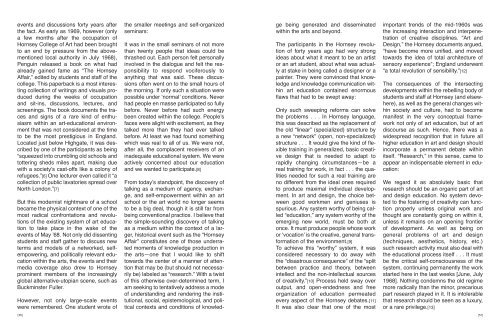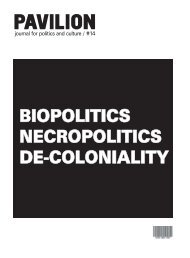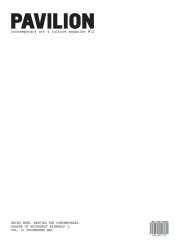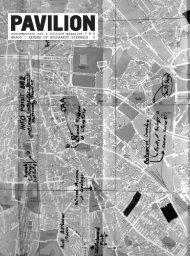Download pdf version of issue no. 16 (4 Mb) - Pavilion
Download pdf version of issue no. 16 (4 Mb) - Pavilion
Download pdf version of issue no. 16 (4 Mb) - Pavilion
Create successful ePaper yourself
Turn your PDF publications into a flip-book with our unique Google optimized e-Paper software.
events and discussions forty years after<br />
the fact. As early as 1969, however (only<br />
a few months after the occupation <strong>of</strong><br />
Hornsey College <strong>of</strong> Art had been brought<br />
to an end by pressure from the abovementioned<br />
local authority in July 1968),<br />
Penguin released a book on what had<br />
already gained fame as “The Hornsey<br />
Affair,” edited by students and staff <strong>of</strong> the<br />
college. This paperback is a most interesting<br />
collection <strong>of</strong> writings and visuals produced<br />
during the weeks <strong>of</strong> occupation<br />
and sit-ins, discussions, lectures, and<br />
screenings. The book documents the traces<br />
and signs <strong>of</strong> a rare kind <strong>of</strong> enthusiasm<br />
within an art-educational environment<br />
that was <strong>no</strong>t considered at the time<br />
to be the most prestigious in England.<br />
Located just below Highgate, it was described<br />
by one <strong>of</strong> the participants as being<br />
“squeezed into crumbling old schools and<br />
tottering sheds miles apart, making due<br />
with a society’s cast-<strong>of</strong>fs like a colony <strong>of</strong><br />
refugees.”[6] One lecturer even called it “a<br />
collection <strong>of</strong> public lavatories spread over<br />
North London.”[7]<br />
But this modernist nightmare <strong>of</strong> a school<br />
became the physical context <strong>of</strong> one <strong>of</strong> the<br />
most radical confrontations and revolutions<br />
<strong>of</strong> the existing system <strong>of</strong> art education<br />
to take place in the wake <strong>of</strong> the<br />
events <strong>of</strong> May ’68. Not only did dissenting<br />
students and staff gather to discuss new<br />
terms and models <strong>of</strong> a networked, selfempowering,<br />
and politically relevant education<br />
within the arts, the events and their<br />
media coverage also drew to Hornsey<br />
prominent members <strong>of</strong> the increasingly<br />
global alternative-utopian scene, such as<br />
Buckminster Fuller.<br />
However, <strong>no</strong>t only large-scale events<br />
were remembered. One student wrote <strong>of</strong><br />
[56]<br />
the smaller meetings and self-organized<br />
seminars:<br />
It was in the small seminars <strong>of</strong> <strong>no</strong>t more<br />
than twenty people that ideas could be<br />
thrashed out. Each person felt personally<br />
involved in the dialogue and felt the responsibility<br />
to respond vociferously to<br />
anything that was said. These discussions<br />
<strong>of</strong>ten went on to the small hours <strong>of</strong><br />
the morning. If only such a situation were<br />
possible under ‘<strong>no</strong>rmal’ conditions. Never<br />
had people en masse participated so fully<br />
before. Never before had such energy<br />
been created within the college. People’s<br />
faces were alight with excitement, as they<br />
talked more than they had ever talked<br />
before. At least we had found something<br />
which was real to all <strong>of</strong> us. We were <strong>no</strong>t,<br />
after all, the complacent receivers <strong>of</strong> an<br />
inadequate educational system. We were<br />
actively concerned about our education<br />
and we wanted to participate.[8]<br />
From today’s standpoint, the discovery <strong>of</strong><br />
talking as a medium <strong>of</strong> agency, exchange,<br />
and self-empowerment within an art<br />
school or the art world <strong>no</strong> longer seems<br />
to be a big deal, though it is still far from<br />
being conventional practice. I believe that<br />
the simple-sounding discovery <strong>of</strong> talking<br />
as a medium within the context <strong>of</strong> a larger,<br />
historical event such as the “Hornsey<br />
Affair” constitutes one <strong>of</strong> those underrated<br />
moments <strong>of</strong> k<strong>no</strong>wledge production in<br />
the arts—one that I would like to shift<br />
towards the center <strong>of</strong> a manner <strong>of</strong> attention<br />
that may be (but should <strong>no</strong>t necessarily<br />
be) labeled as “research.” With a twist<br />
<strong>of</strong> this otherwise over-determined term, I<br />
am seeking to tentatively address a mode<br />
<strong>of</strong> understanding and rendering the institutional,<br />
social, epistemological, and political<br />
contexts and conditions <strong>of</strong> k<strong>no</strong>wled-<br />
ge being generated and disseminated<br />
within the arts and beyond.<br />
The participants in the Hornsey revolution<br />
<strong>of</strong> forty years ago had very strong<br />
ideas about what it meant to be an artist<br />
or an art student, about what was actually<br />
at stake in being called a designer or a<br />
painter. They were convinced that k<strong>no</strong>wledge<br />
and k<strong>no</strong>wledge communication within<br />
art education contained e<strong>no</strong>rmous<br />
flaws that had to be swept away:<br />
Only such sweeping reforms can solve<br />
the problems . . . In Hornsey language,<br />
this was described as the replacement <strong>of</strong><br />
the old “linear” (specialized) structure by<br />
a new “network” (open, <strong>no</strong>n-specialized)<br />
structure . . . It would give the kind <strong>of</strong> flexible<br />
training in generalized, basic creative<br />
design that is needed to adapt to<br />
rapidly changing circumstances—be a<br />
real training for work, in fact . . . the qualities<br />
needed for such a real training are<br />
<strong>no</strong> different from the ideal ones required<br />
to produce maximal individual development.<br />
In art and design, the choice between<br />
good workmen and geniuses is<br />
spurious. Any system worthy <strong>of</strong> being called<br />
“education,” any system worthy <strong>of</strong> the<br />
emerging new world, must be both at<br />
once. It must produce people whose work<br />
or ‘vocation’ is the creative, general transformation<br />
<strong>of</strong> the environment.[9]<br />
To achieve this “worthy” system, it was<br />
considered necessary to do away with<br />
the “disastrous consequence” <strong>of</strong> the “split<br />
between practice and theory, between<br />
intellect and the <strong>no</strong>n-intellectual sources<br />
<strong>of</strong> creativity.”[10] Process held sway over<br />
output, and open-endedness and free<br />
organization <strong>of</strong> education permeated<br />
every aspect <strong>of</strong> the Hornsey debates.[11]<br />
It was also clear that one <strong>of</strong> the most<br />
important trends <strong>of</strong> the mid-1960s was<br />
the increasing interaction and interpenetration<br />
<strong>of</strong> creative disciplines. “Art and<br />
Design,” the Hornsey documents argued,<br />
“have become more unified, and moved<br />
towards the idea <strong>of</strong> total architecture <strong>of</strong><br />
sensory experience”; England underwent<br />
“a total revolution <strong>of</strong> sensibility.”[12]<br />
The consequences <strong>of</strong> the intersecting<br />
developments within the rebelling body <strong>of</strong><br />
students and staff at Hornsey (and elsewhere),<br />
as well as the general changes within<br />
society and culture, had to become<br />
manifest in the very conceptual framework<br />
<strong>no</strong>t only <strong>of</strong> art education, but <strong>of</strong> art<br />
discourse as such. Hence, there was a<br />
widespread recognition that in future all<br />
higher education in art and design should<br />
incorporate a permanent debate within<br />
itself. “Research,” in this sense, came to<br />
appear an indispensable element in education:<br />
We regard it as absolutely basic that<br />
research should be an organic part <strong>of</strong> art<br />
and design education. No system devoted<br />
to the fostering <strong>of</strong> creativity can function<br />
properly unless original work and<br />
thought are constantly going on within it,<br />
unless it remains on an opening frontier<br />
<strong>of</strong> development. As well as being on<br />
general problems <strong>of</strong> art and design<br />
(techniques, aesthetics, history, etc.)<br />
such research activity must also deal with<br />
the educational process itself . . . It must<br />
be the critical self-consciousness <strong>of</strong> the<br />
system, continuing permanently the work<br />
started here in the last weeks [June, July<br />
1968]. Nothing condemns the old regime<br />
more radically than the mi<strong>no</strong>r, precarious<br />
part research played in it. It is intolerable<br />
that research should be seen as a luxury,<br />
or a rare privilege.[13]<br />
[57]








